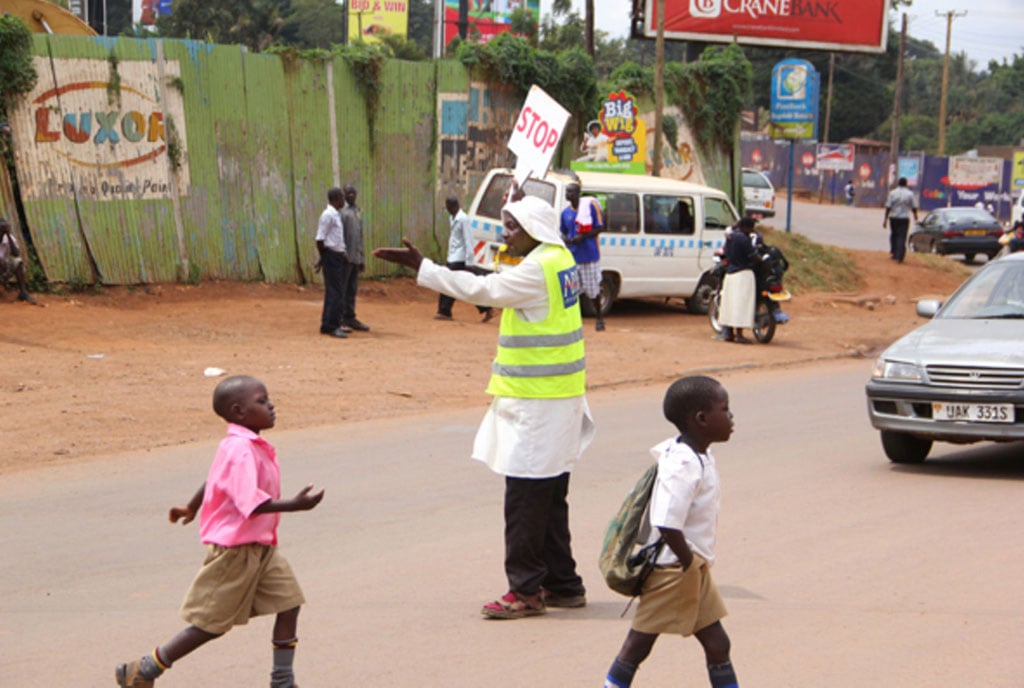Prime
Slow down, back to school means sharing the road

Pupils cross a road in Kampala. PHOTO/FILE
What you need to know:
- As a driver, you must understand the traffic laws for school zones and follow them at all times.
On February 8, 12-year-old Alice Sheila Namwanje, a pupil at Naluse Primary School in Butebe Cell, Mukono Municipality, while crossing the road from her home in Upper Kauga Village, Mukono District, was run over by a Kampala-bound double cabin Hilux. Sensing danger, the driver of the Hilux sped off immediately.
The incident left three others, including Jennifer Namatovu, Namwanje’s classmate, Paul Kalyango, a teacher at St Joseph’s Senior Secondary School Naggalama and Diana Namulindwa, a Senior Two student of Bishop Senior Secondary School, severely injured.
Ethically, the way you drive within or around school zones differs from the way you drive in other places. Much as most schools are always surrounded by perimeter walls, permanent or temporary, it does not mean that you drive the way you wish simply because you are in a rush.
John Mukisa, a motorist, says when picking his children from school, he always expects children to cross the road from any direction at any time and, therefore, he drives at the lowest speed.
“Regardless of whether there are humps in a school zone or not, I respect the law and drive below five kilometres per hour. I consider the fact that at any one time, a child might be crossing,” Mukisa explains.
Speed limits
In Kampala and Wakiso districts, most children use public transport, while a large number walk to and from school. Without safer infrastructure such as gazetted and protected roadside walkways on all roads, these children become susceptible to road crashes.
Rogers Kauma Nsereko, the Kampala Metropolitan traffic commandant, emphasises the need for all motorists and motorcyclists to observe the recommended driving speeds in Kampala, especially now that schools have reopened.
He says the maximum speed for driving in urban and built up areas with a big population regardless of whether they are school zones or not was revised from 50km/hr to 30km/hr.
“Around school zones, it should even be lower because there are many children leaving or going to school. If you knock or injure a pupil around a school zone, the only penalty is being arraigned before a court of law,” Nsereko warns, adding that careless driving or driving above the prescribed speeds around school zones calls for a penalty of Shs200,000.
Road signage
Nsereko advises school authorities to work with concerned authorities such as Kampala Capital City Authority (KCCA) and traffic police to install road signage such as speed limit signs, zebra crossings and speed calmers, or road humps around school zones surrounded by public roads. This should be in addition to having traffic marshals to help children cross roads.
“In absence of traffic personnel because of limited manpower, as a school, you should employ traffic marshals to help children cross the road as they leave and enter school on top of installing road markings. Some schools have parking yards or drop off points on one side and the school on another because of space constraints,” Nsereko advises.
Reynolds Kibira-Kadok, the deputy vice president in charge of vintage, touring and road safety at the Federation of Motorsports Clubs of Uganda (FMU), says the recently concluded school zones assessment skills training in Wakiso District organised by FMU, was aimed at educating and engaging key stakeholders such as district school administration, head teachers, road engineers, transporters, traffic police and civil society to appreciate road safety concerns for school going children and to demonstrate to authorities from an engineering perspective how road infrastructure upgrades would improve road safety in school zones.
Key facts
According to the World Health Organisation (WHO) global status report on road safety, globally, road traffic injuries are the eighth leading cause of death for all age groups. The report observes that nearly 220,000 children and adolescents aged 0-19 die annually due to road traffic injuries. This is equivalent to or more than 600 preventable child deaths every two minutes. It also states that road traffic injuries are the second leading cause of death for children aged five to nine and 10 to 14 years and the leading cause of death for adolescents aged 15-19 years.
Road traffic injuries are the are the tenth leading cause of years lived with a disability among children aged 15 to 19 and the thirteenth overall cause of years lived with disability for children zero to 19 years.
Some of the measures the WHO recommends to middle and low income countries such as Uganda to prevent or reduce road traffic child deaths include controlling speed from 50km/hr to 30km/hr especially in urban and built up areas. This is because the speed at which a vehicle travels directly influences the risk of a crash as well as the severity of injuries and likelihood of death resulting from that crash.
Others include reducing drink-driving, use of crash helmets, especially for motorcyclists and their passengers and use of effective and appropriate child restraints in vehicles, enhancing children’s visibility, improving road infrastructure, particularly to facilitate safe walking and cycling and improving post-crash care and recognising the specific and different needs of children.
Tips
A few precautions go a long way toward keeping children safe:
• Do not block the crosswalk when stopped at a red light or waiting to make a turn, forcing pedestrians to go around you; this could put them in the path of moving traffic.
• In a school zone when flashers are blinking, stop and yield to pedestrians crossing.
• Always stop for a school traffic marshal holding up a stop sign.
• Take extra care to look out for children in school zones, near playgrounds and parks, and in all residential areas.
• Do not honk or rev your engine to scare a pedestrian, even if you have the right of way.
• Never pass a vehicle stopped for pedestrians.




